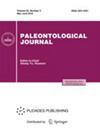第7章早前寒武纪铁纹石英岩(Jaspilites)
IF 0.6
4区 地球科学
Q4 PALEONTOLOGY
引用次数: 0
摘要
摘要 在卡累利阿和科拉半岛的 2.7-2.8 Ga 带状铁纹石英岩中发现了可能来自细菌的微化石。有机碳含量的测定和平衡计算表明,这些铁锈色石英岩是在富含有机物的环境中堆积而成的。对现代微生物和新石器时代微生物形态的比较分析表明,所研究石英岩中的部分磁铁矿来源于细菌。本文章由计算机程序翻译,如有差异,请以英文原文为准。

Chapter 7. Early Precambrian Ferruginous Quartzites (Jaspilites)
Abstract
Microfossils of presumably bacterial origin were found in 2.7–2.8 Ga banded ferruginous quartzites in Karelia and the Kola Peninsula. The determination of organic carbon content and balance calculations showed that these ferruginous quartzites accumulated in an organic-rich environment. A comparative analysis of the morphology of modern and Neoarchaean microorganisms suggests the bacterial origin of some of the magnetite in the studied quartzites.
求助全文
通过发布文献求助,成功后即可免费获取论文全文。
去求助
来源期刊

Paleontological Journal
地学-古生物学
CiteScore
1.20
自引率
33.30%
发文量
70
审稿时长
6-12 weeks
期刊介绍:
Paleontological Journal (Paleontologicheskii zhurnal) is the principal Russian periodical in paleontology. The journal publishes original work on the anatomy, morphology, and taxonomy of fossil organisms, as well as their distribution, ecology, and origin. It also publishes studies on the evolution of organisms, ecosystems, and the biosphere and provides invaluable information on global biostratigraphy with an emphasis on Eastern Europe and Asia.
 求助内容:
求助内容: 应助结果提醒方式:
应助结果提醒方式:


